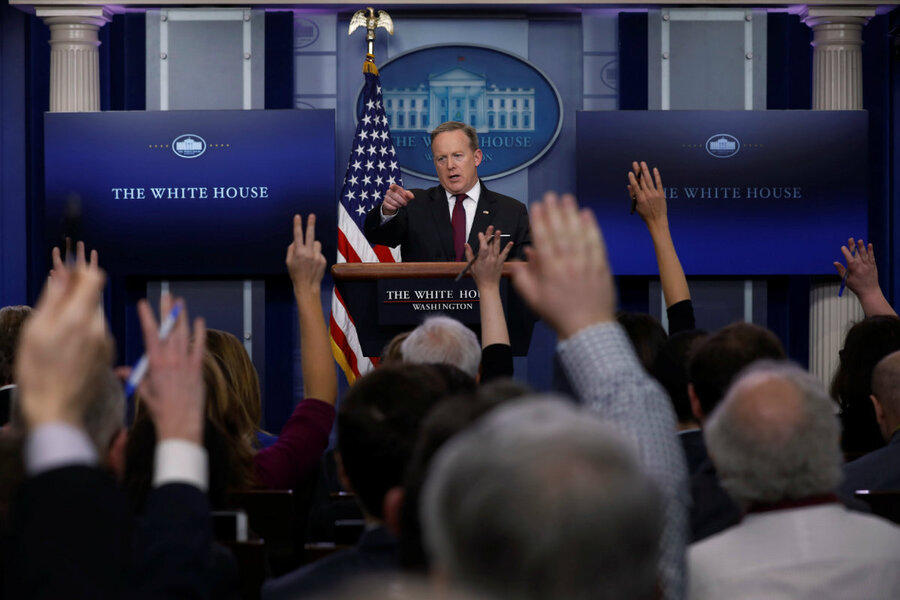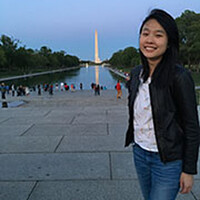White House blocks reporters from a briefing, shrugging off another unwritten custom
Loading...
Several major news outlets, including the New York Times, CNN, and the Los Angeles Times, were blocked from an off-camera press briefing on Friday, igniting furious criticism from media organizations.
The White House said it was adhering to ordinary press customs by holding an "expanded pool," but observers call the incident another sign of the troubled relationship between President Trump and the media.
A restricted non-televised briefing, or "gaggle," replaced an earlier-planned full, on-camera briefing in the official White House briefing room, reported Politico. While reporters from BBC, Politico, and BuzzFeed were also excluded, journalists from 11 other news organizations such as Reuters, CBS, and NBC did attend the meeting. However, it was the selective invitation of conservative outlets, such as One America News Network, Breitbart, and Washington Times, some of whom have been overtly favorable to the Trump administration, that led to the controversy.
“We invited the pool so everyone was represented,” deputy press secretary Sarah Sanders told the Washington Post in an email. “We decided to add a couple of additional people beyond the pool for an expanded pool. Nothing more than that.”
A small group of reporters, from all kinds of news media, serve on a rotating basis as the “pool,” and are responsible for providing notes and transcripts of meetings to the entire White House press corps. It is not uncommon for the White House press secretaries to brief just the pool or host small gaggles with a handpicked “expanded pool,” typically for specific topics.
Yet, after press secretary Sean Spicer decided to expand the pool, his staff explicitly denied entrance to reporters from several prominent news outlets, especially those that Trump has targeted as unfairly biased against him.
Inviting conservative-slanted sources while blocking unbiased and liberal-slanted sources is unusual, if not unprecedented, the Washington Post reported.
“Nothing like this has ever happened at the White House in our long history of covering multiple administrations of different parties,” said Dean Baquet, executive editor of The New York Times, in a statement. “Free media access to a transparent government is obviously of crucial national interest.”
Reporters from the Associated Press and Time were invited to the meeting but decided to sit out, in an act of solidarity with the excluded reporters. Reporters for the Wall Street Journal and McClatchy attended the meeting but later indicated that they had not realized Mr. Spicer was barring other outlets, and they pledged to boycott similar arrangements in the future.
The event adds to a list of unwritten customs that Trump and his team are changing or ignoring, from not releasing the president's tax returns to holding working weekends at a Florida club instead of Camp David or the White House itself.
One of the most prominent media-related changes before now was the president's apparent preference for making major announcements via Twitter instead of hosting press conferences, as his predecessors tended to do.
Repeatedly calling several news outlets “fake news,” the president has also declared media “the enemy of the people,” a claim he repeated during his speech at the Conservation Political Action Conference on Friday.
As press secretary, Spicer has “upended some of the longstanding traditions surrounding the nearly daily press conference,” as the New York Times detailed on Feb. 11, from choosing unusual news sources to ask the first questions to having “Skype seats” for reporters from local news outlets.
These changes, large and small, have collectively shaken the media landscape, say experts, who say a mutually beneficial relationship between the press and president is crucial.
“In some ways I don’t think [the Trump administration] wants to interact with the institutional press, which is a huge problem,” Roy Gutterman, director of the Tully Center for Free Speech at Syracuse University in New York, told The Christian Science Monitor in November. “Our independent press is an integral part of our democracy, it has been since the beginning of our country, and the public really needs to know what’s going on.”
This report includes material from Reuters.








